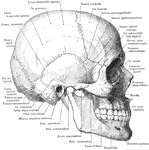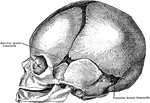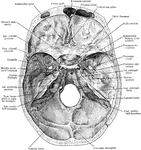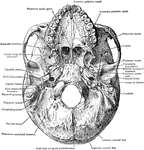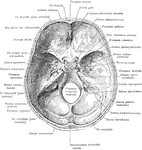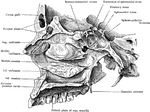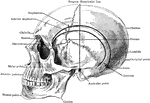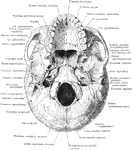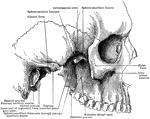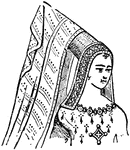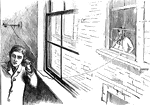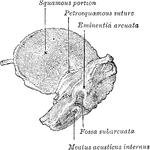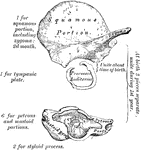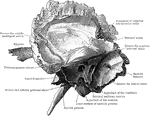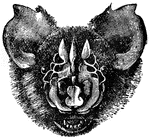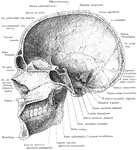
Median Section of the Skull and Mandible
Median section of the skull and mandible, viewed from the left.

Ox Skull
Skull of an ox, superior aspect. Labels: a, frontal crest; b, lateral crest; c, horn core; d, nasal…
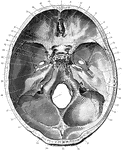
Base of the Skull Seen From Above
Shown is the base of the skull seen from above. Labels: 1, frontal bone; 2, slit for nasal nerve; 3,…
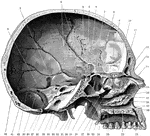
Skull Seen From Side
Shown is the inner aspect of the left half of the skull sagittally divided. Labels: 1, suture between…
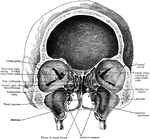
Frontal Section of Skull Showing Nasal Cavity
Front section of skull through plane of outer border of orbits. Arrows pass through communication between…

Skull Showing Posterior Wall of Sphenomaxillary Fossa
Portion of right half of skull, showing posterior wall of sphenomaxillary fossa. The superior maxilla,…

Base of the Skull
Shown is norma basalis, which refers to the base of the cranium. Labels: 1, external occipital crest;…

Coronal Section of Skull
Shown is a coronal section passing inferiorly through interval between between the first and second…
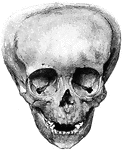
Deformed skull
"Showing how the Bones of the Skull may be artificially deformed by "head-binding." From the photograph…

Front of the Skull
Shown is norma frontalis, which refers to the front of the skull. Labels: 1, mental protuberance; 2,…
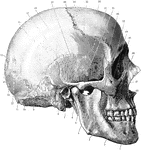
Side of the Skull
Shown is norma lateralis, which refers to the side of the skull. Labels: 1, mental foramen; 2, body…
Spermatozoa of an Ape
"One of the numberless microscopic bodies contained in semen, to which the seminal fluid owes its vitality,…

Sphenoid Bone of the Human Skull
Sphenoid bone, situated the anterior part of the base of the skull, articulating with all the other…
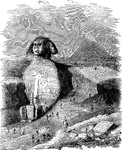
The Great Sphinx at Giza
A statue built on the Giza Plateau in Giza, Egypt, consisting of a lion with a human head. The Sphinx…
Dock Spike
"A large nail or pin, generally of iron. The larger forms of spikes, particularly railroad spikes, are…
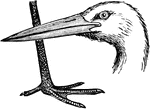
Stork Head and Leg
The head and leg of the stork, a bird in the Ciconiidae family of storks, herons, and egrets.

Decorative Floral T
An ornate capital T surrounded by leaves and vines, used at the start of a new chapter or heading.

Temporal Bone at Birth
A, The outer surface of the right temporal bone at birth. B, The same with squamozygomatic portion removed.…
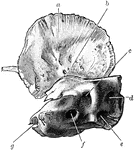
Temporal Bone at Birth
Inner surface of right temporal bone at birth. am squamozygomatic; b, petrosquamosal suture and foramen…

Temporal Bone of the Human Skull
Temporal bone of the human skull. The temporal bones are situated at the sides and base of the skull.…
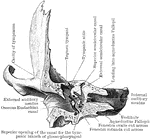
Anterior Half of Section Through Temporal Bone
The anterior half of a vertical transverse section through the left temporal bone.
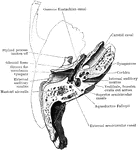
Horizontal Section of Temporal Bone
Horizontal section through left temporal bone showing lower half of section.
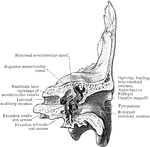
Posterior Half of Section Through Temporal Bone
The posterior half of a vertical transverse section through the left temporal bone.

Temporal Muscle
The temporal muscle is a broad muscle situated at the side of the head and occupying the entire extent…

Head of a thyrsus
"Shows the head of a thyrsus composed of the leaves and berries of the ivy, and surrounded by acanthus…

Roman Table Support Trapezophoron
The Roman table support Trapezophoron is a marble design of a lion head and claw.

Roman Table Support Trapezophoron
The Roman table support trapezophoron is a marble design of a Lynx head and claw.
Roman Table Support Trapezophoron
The Roman table support trapezophoron is a marble design of a Lynx head and claw.
Roman Table Support Trapezophoron
The Roman table support Trapezophoron is a marble design of a panther head and claw.

Roman Table Support Trapezophoron
The Roman table support Trapezophoron is a marble design of a panther head and claw.
Roman Table Support Trapezophoron
The Roman table support Trapezophoron is a marble design of a lion head and claw.
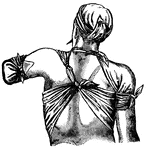
Triangular Bandage
This illustration shows a method of applying a triangular bandage to the chest, shoulder, head and elbow.

Trunk and Head of Human Body
Diagrammatic longitudinal section of the trunk and head. Labels: 1,1, the dorsal cavity; a, the spinal…

Decorative Floral V
An ornate capital V surrounded by leaves and vines, used at the start of a new chapter or heading.

Cross section of a viper head
Section of the head of a serpent. a, poison fangs; b, poison glands; c, conductor for the poison; d,…
